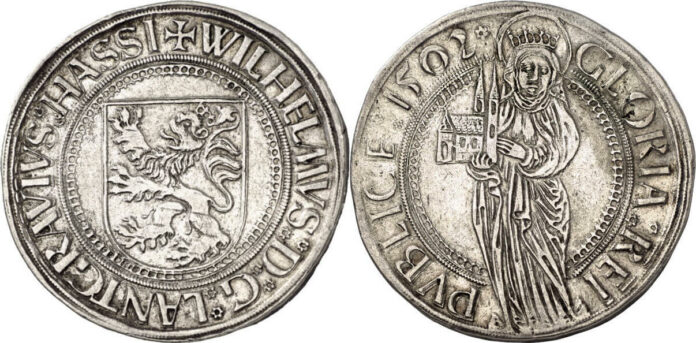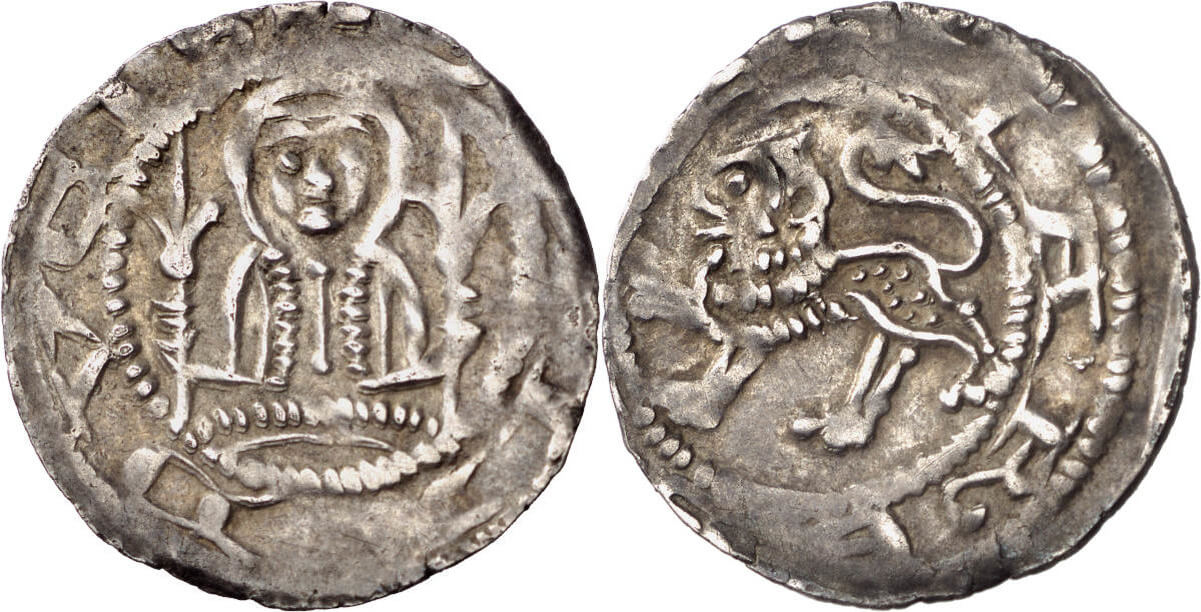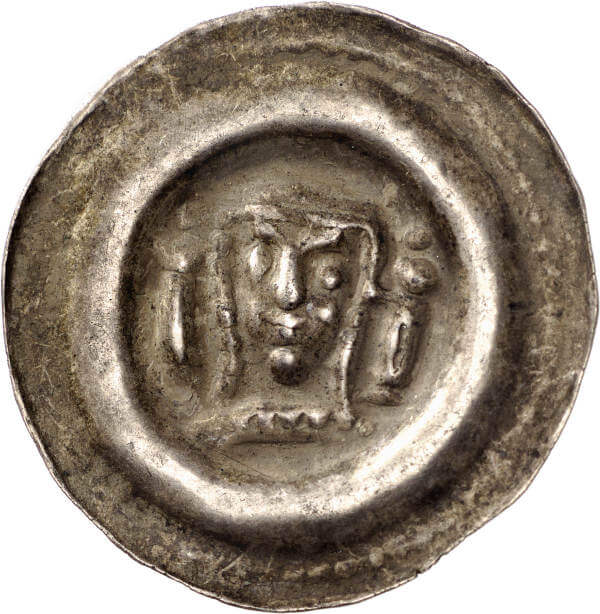On 28 September 2022, Künker will auction off the Loos Collection of coins and medals relating to Hesse. Dr. Hans-Jürgen Loos made it his mission to document the history of his home state by means of this collection. He wanted to provide an overview of monetary history in order to illustrate the past of today’s federal state of Hesse. Honoring him and the concept of his collection, this article isn’t dedicated to a single coin or a specific time period. We will take a much broader perspective: we begin with coins from the first half of the 13th century and end with the Reformation.
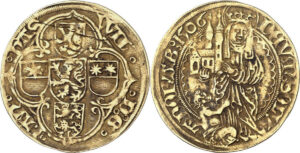
Landgravine Elizabeth
Our point of departure is one of the great rarities from the Loos Collection: a 1506 gold gulden depicting St. Elizabeth on its reverse. She, who is believed to have lived such a humble life, wears a heavy crown on her head and carries a gigantic church model. This tells us that the coin does not depict the historical woman but the venerated saint. The crown was placed on her skull on the occasion of the elevation of her bones, the large Gothic church was built over her humble tomb in Marburg. The beggar crouching at her feet indicates why Elizabeth was raised to the honors of the altars: because of her love for the poor.
But how did a Hessian landgravine become one of the most famous German saints? To understand this, we need to go back many centuries.

This bracteate features a stylized depiction of young Landgrave Louis IV of Thuringia. In 1221, he married Elizabeth, the daughter of the Hungarian king. She bore him three children before Louis IV accompanied Emperor Frederick II in his crusade in 1227. Louis did not even make it to the Holy Land. He already died from a fever before boarding the ship in Otranto. This put his widow Elizabeth, who was merely 20 years old at the time, in an uncomfortable situation: her son was too young to take over the rule. She refrained from doing so herself – for reasons that are best known to her –, which is why the deceased landgrave’s brother, ambitious Henry Raspe, became the new landgrave. Elizabeth left both her home at Wartburg Castle and her children to withdraw into the hospital that she had founded in Marburg. That’s where she died in 1231 with a reputation of holiness.
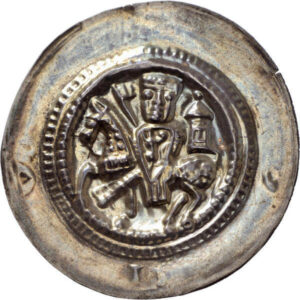
The Canonization
When she died, her son – who can be seen on this bracteate – was nine years old, and the ruler’s name was still Henry Raspe. Due to the will of his pious but somewhat obstinate sister-in-law, the latter was faced with a problem. For she did not leave the Marburg hospital and its vast estate to her descendants but to the neighboring commandery of the Order of Saint John. This meant that the Landgraves of Thuringia were to lose a significant amount of power. To prevent this, Conrad Raspe, the youngest brother of Louis IV, took over the estate – despite the will. As the patron of the Order of Saint John, the archbishop of Mainz opposed to this. Of course, this resulted in a war, a war that was waged on all levels, using propaganda and military force.
For Henry and Conrad Raspe wanted to convince the Pope to canonize their sister-in-law Elizabeth. They believed that her aura of holiness might rub off on them if their undertaking succeeded. However, military matters got out of hand: the troops of Conrad Raspe stormed Fritzlar on 15 September 1232, which belonged to the archbishopric of Mainz at the time. They caused so much damage that the archbishop succeeded in having the pope excommunicate Conrad. Obviously, the canonization of Elisabeth was now out of the question!
Conrad didn’t have a choice but to make a pilgrimage to Rome in the summer of 1234, to offer his apologies and to negotiate a compromise. This compromise was the following: the hospital and its vast estate would not go into the possession of the Order of Saint John but into that of the Teutonic Order. Conrad Raspe gave up his secular power to join the Teutonic Order in the November of 1234, probably already knowing that he would succeed the Grand Master himself after his death, which happened in 1239. The process of canonizing Elisabeth was resumed. It ended with her being canonized of 1 June 1235.
The Elevation of the Bones
On the eve of the great celebrations, representatives of the Teutonic Order opened the landgravine’s tomb, removed the bones, washed and anointed them. For her two daughters, a rib and an arm were put aside. The head was cut off too, before the Teutonic Knights wrapped the bones in a precious, purple-dyed cloth to place them in a lead coffin.
On the next morning, 1 May 1236, the Emperor Frederick II, followed by numerous imperial princes, went barefoot and in penitential robes to the tomb of Elizabeth. Her coffin was then carried to the altar. Her head was embedded in a golden cup and a golden crown was placed on it. Later, it was reburied in a head reliquary, which was venerated for many centuries in St. Elizabeth’s Church.
At the time of the elevation of the relics, this new church was already being built in Marburg. Along with the canonization, the Pope had sent a letter promising a decent indulgence to anyone who donated to the construction of the new St. Elizabeth’s Church. Following the example of French cathedrals, this is how Germany’s oldest purely Gothic church was built, and it immediately became an important pilgrimage site.
For Henry Raspe this was such an increase in prestige that, after the deposition of Emperor Frederick II, he had himself nominated and elected German anti-king.
A Dispute over Inheritance
Conrad Raspe died in 1240, Landgrave Hermann II in 1242, Henry Raspe in 1247. Neither of them left a son. Thus, the male branch of the family had died out and the dispute over the inheritance could begin. Henry II, Duke of Brabant and Lothier, who had married Sophie, the daughter of St. Elizabeth and Louis IV, had good prospects. As early as in 1247, he moved with some troops to Marburg to lay his claim. However, Henry of Brabant died less than six months later. His heir, a son from his first marriage, wasn’t interested in enforcing the inheritance claims of his little brother. That’s why Sophie was on her own when she decided to protect the rights of four-year-old Henry.
She took advantage of the prestige it gave her to be descended form a saint. The daughter of St. Elizabeth, as she referred to herself in official documents, did not have her coins depict the image of her son, as might have been expected. Instead, she had the coins feature her own portrait, and added the title of duchess to it that she had acquired through marriage. This was quite unusual for a woman of her time. Although she did not succeed in thwarting the takeover of Thuringia by the House of Wettin, at least the Bishop of Mainz, who had tried to annex the Hessian estates, had to give in.
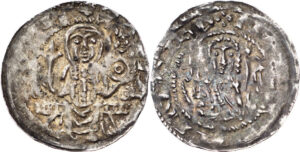
The descendants of St. Elizabeth and Sophie of Thuringia remained rulers of the Landgraviate of Hesse for many centuries.
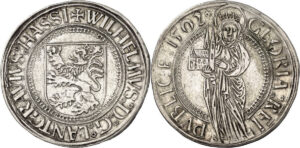
But why did Landgrave William II invoke St. Elizabeth in such a way on his coins? To tell the complete story, we need a crucial and extremely rare coin that is missing in the Loos Collection. That’s why we depict a piece that was auctioned off in Künker’s auction 371.
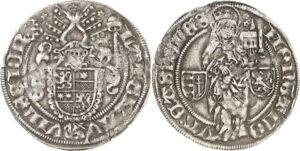
It wasn’t issued by Landgrave William II but by his older brother William I, a religious dreamer who is said to have worshipped his ancestor, St. Elizabeth, with great effusion. In 1491, he set out on a pilgrimage to the Holy Land and returned in a state of mind that made it impossible for him to rule a state. As to why this was the case, we have to speculate. His contemporaries blamed the courtesans of Venice. He had probably contracted syphilis, which, in its final stage, can lead to dementia. The reign was taken over by power-conscious William II, who in turn knew to use St. Elizabeth to increase his reputation.
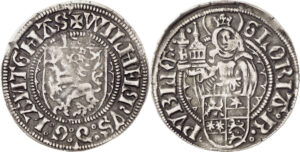
In 1497, he married the sister of the rich Duke of Lorraine, who brought a dowry of 32,000 Rhenish gold gulden into the marriage. William received his bride programmatically at the tomb of St. Elizabeth.
A convenient death as well as the fruitful cooperation with Emperor Maximilian I made William II one of the most important princes of the empire. He was able to expand his territory drastically and took the new economic areas into account by implementing a coinage reform in 1502. The highest denomination of the reform was the guldengroschen of 27 albus of 12 hellers each. One year later – in 1503 – the emperor granted William II the right to mint his own gold coins. All new coins featured Elizabeth.
However, William II too fell ill – this time we know it for sure – with syphilis around 1505. He spent the last years of his life raging in confinement. When William died in 1509 under the most miserable circumstances, he left a minor son named Philip, whom Protestant historians were to call “the Magnanimous”.
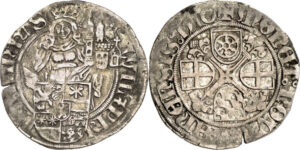
And then came the Reformation. Landgrave Philip himself was a member of the college of Imperial Princes at the Diet of Worms when Luther refused to recant his writings. Just sixteen years old, he was one of the many imperial princes who supported Luther and his desire to reform the church. One of the reasons for this was that Philip’s chancellor personally knew the reformer from his student days.
In 1526, Philip introduced the Reformation, in 1528 he triggered the first armed conflict of the wars of religion. In 1529, he was the eloquent leader of those who would go down in history as Protestants due to their protest at the Diet of Speyer.

And then he suffered the same faith as his uncle and his father before – syphilis got in the way. He displayed first symptoms in 1539. It is easy to imagine how desperate the prince must have been. A child of his time, Philip associated his illness with his lifestyle, which was rather hedonistic even by the standards of his time. He believed that his wife – who, by the way, had already borne him ten children by then – wasn’t enough. To avoid sacrilegious consorting with concubines, Philip pressured the Reformed theologians to grant him a special permit for bigamy.
And he went a step further to regain God’s favor and thus to defeat the disease. He had already prohibited anyone from accessing the tomb in 1528 in order to stop pilgrimage. Now, under tumultuous circumstances, as Nikolot Klüssendorf put it, the bones of St. Elizabeth were removed from her tomb. They are said to have returned to the Teutonic Order only after Philip’s defeat in the Schmalkaldic War. Another legend has it that they were saved and taken to the convent of the Sisters of St. Elizabeth in Vienna, where they are still on display today. However, St. Elizabeth’s Church in Marburg never regained its importance as a place of pilgrimage.
Nevertheless, Philip still issued coins with the image of St. Elizabeth made from old dies. The end of depictions of St. Elizabeth on coins cannot be specifically linked to Philip’s taking measures against pilgrimage. Moreover, as a pious ancestress, Elizabeth remained a figure of identification of the Hessian Landgraviate. Until this day, we can find her depictions time and again.
Literature:
- Niklot Klüssendorf, Die heilige Elisabeth im hessischen Münzbild. Published in: Abhandlungen der Braunschweigischen Wissenschaftlichen Gesellschaft volume 56, 2005, pps 51-89
- Hans Philippi, Das Haus Hessen. Ein europäisches Fürstengeschlecht. Kassel (1983)
More coins and medals of the Loos Collection can be found in the online catalog of Künker Auction 374.
Read here how Landgrave Karl turned Hesse into a military power.
Learn more about Louis VIII, Landgrave of Hesse, and his love of hunting.




